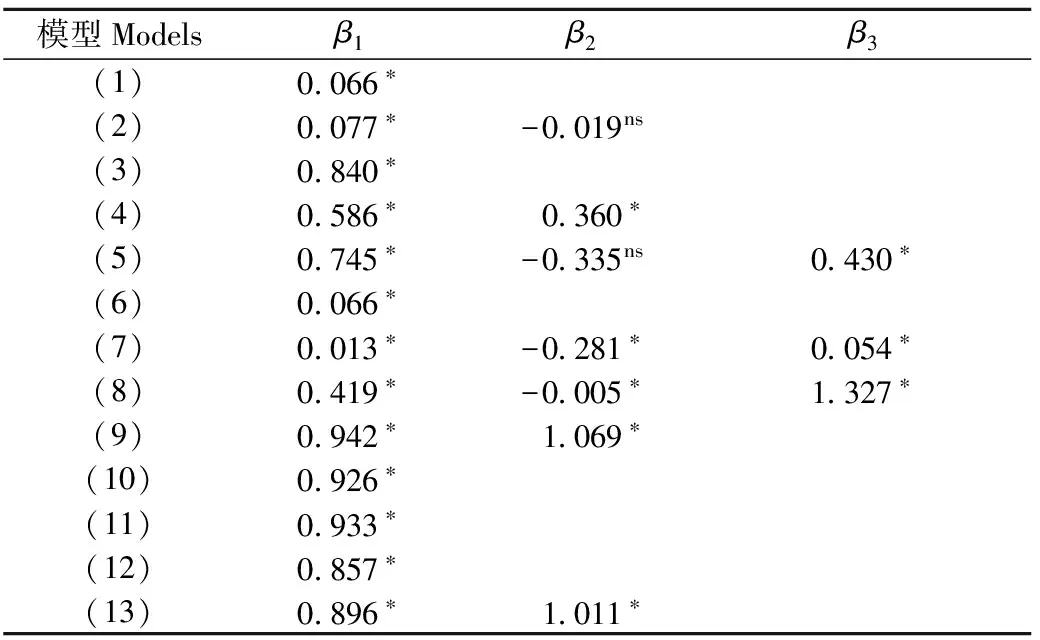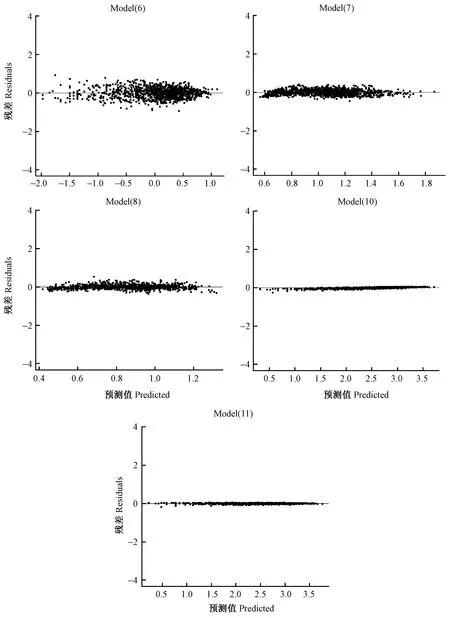西南桦人工林树皮厚度模型模拟*
唐 诚 王春胜 庞圣江 黄日逸 曾 杰
(1.中国林业科学研究院热带林业研究所 广州 510520; 2.石河子大学农学院 石河子 832003;3.中国林业科学研究院热带林业实验中心 凭祥 536000)
西南桦人工林树皮厚度模型模拟*
唐 诚1,2王春胜1庞圣江3黄日逸3曾 杰1
(1.中国林业科学研究院热带林业研究所 广州 510520; 2.石河子大学农学院 石河子 832003;3.中国林业科学研究院热带林业实验中心 凭祥 536000)
【目的】 开展西南桦人工林树皮厚度模型模拟,为估算西南桦材积、出材量以及树皮蓄积量奠定基础。【方法】 通过树干解析获取各区分段的带皮直径、去皮直径和树皮厚度等信息,按照约75%和25%的比例随机分为建模和检验数据集。选取13个模型,运用最小二乘法进行拟合,并对模型参数进行显著性检验(显著性水平0.05)。对于参数检验显著的模型,依据偏差、绝对偏差、均方误差和决定系数4个统计指标,应用相对排序法评价模型拟合优度。采用配对t检验方法检验模型的有效性,剔除预估值和实测值差异显著的模型,进一步诊断保留模型的共线性以及异方差性,最终筛选出适于拟合西南桦人工林树皮厚度的模型。【结果】 模型参数显著性检验结果表明,在13个模型中,模型(2)和(5)有参数与零差异不显著(P≥0.05),其余模型的所有参数均显著(P<0.05)。依据统计指标对11个模型进行综合排序,模型(3)和(4)拟合胸高处树皮厚度的效果相近,优于模型(1); 模型(7)对于任意高度处树皮厚度的拟合效果优于模型(6); 模型(8)拟合相对树皮厚度的效果优于模型(9); 模型(11)和(13)对去皮直径的拟合效果优于模型(10)和(12)。t检验结果表明,模型(9)、(12)和(13)的预估值与实测值差异显著,予以剔除。剩余8个模型中,模型(4)存在较弱共线性,其他模型均不存在共线性问题。由残差图分析和怀特检验可知,模型(1)、(3)和(4)不存在异方差性,模型(6)、(7)、(8)、(10)和(11)均存在明显的异方差性,通过变量变换其异方差性得到较好修正。【结论】 拟合西南桦胸高处树皮厚度、任意高度处树皮厚度、相对树皮厚度和去皮直径4个树皮因子,宜分别选用模型(3)、(7)、(8)和(11)。林业调查工作中胸径容易测定,且人工林年龄数据容易获取,任意高度处直径可用林分速测镜快速测定,这些模型的应用简单可行。树皮厚度除受年龄、树高、胸径等林木因子影响外,还可能受立地因子影响,未来需综合考虑以提高模型拟合精度。
西南桦; 树皮因子; 相对排序法; 残差分析
树皮不仅是生物能源、单宁提取的重要原料,亦是景观覆盖物等的优良材料,而且树皮作为药材也比较常见,其经济价值高(Marshalletal., 2006; Williamsetal., 2007)。树皮是树木有机体的组成部分,估测树皮厚度对于树木材积、出材量以及树皮蓄积量的估计至关重要(Gordon, 1983)。
树皮厚度往往因树种而异,如希腊北部白冷杉(Abiesconcolor)的平均树皮厚度为10.2~17.8 cm,白云杉(Piceaglauca)和黑云杉(Piceamariana)的平均树皮厚度仅0.6~1.3 cm(Kitikidouetal., 2014)。而且随着林木直径增大,树皮亦相应增厚,如Paine等(2010)在研究法国圭亚那热带低地雨林阔叶树种的树皮厚度时发现,其直径每增加10 cm,树皮厚度约增加1.2 mm; 陈东来等(1994)对白桦(Betulaplatyphylla)、山杨(Populusdavidiana)的研究也显示其树皮随着直径、树高的增大而增厚。Richardson等(2015)研究指出,针叶树种树皮厚度受直径的影响程度小于常绿阔叶树种。目前,有关阔叶树种树皮厚度的文献报道相对较少。
许多学者应用胸径、树高或年龄拟合模型估算胸高处树皮厚度(Laasasenahoetal., 2005; Sonmezetal., 2007; Williamsetal., 2007; 王晓林等, 2011),由于树皮厚度往往随着树干高度而变化,任意高度处树皮厚度的估计同样受到重视(Maguireetal., 1989; Laasasenahoetal., 2005; Brooksetal., 2009)。也有一些学者通过拟合相对树皮厚度(Johnsonetal., 1987; Maguireetal., 1989; Laasasenahoetal., 2005)、树皮率(Caoetal., 1986; Lietal., 2010)以及去皮直径(Coleetal., 1972; Dolph, 1989; Lietal., 2010)的模型估计树皮厚度。
西南桦(Betulaalnoides)是天然分布于东南亚以及我国南方的速生珍贵阔叶树种,其木材广泛应用于木地板、家具制作以及建筑装饰中(曾杰等, 2006),树皮除了可作燃料、提取栲胶外,其提取物还具有抗炎、减肥及降血脂等功效(Suretal., 2002;Rajetal., 2015; Velavan, 2014)。近10多年来,西南桦木材及其产品的市场需求量巨大,我国西南桦种植业发展迅速,其人工林面积已超过 15万hm2(王春胜等, 2013),预计未来10年内将有大量人工林进入成熟林阶段。西南桦树皮厚度估计无论对于树皮利用还是木材生产均至关重要,然而目前尚没有合适的模型估算其树皮厚度。鉴于此,本研究通过查阅文献收集及自建树皮模型,应用前期西南桦树干解析所获带皮直径、去皮直径、树皮厚度等数据进行模型拟合,比较分析不同模型的拟合效果,从而筛选出各类树皮因子估测的适宜模型,为估算西南桦材积、出材量以及树皮蓄积量奠定基础。
1 材料与方法
1.1 数据收集
考虑不同年龄、海拔、坡向、坡位等因子,选取117株解析木,其中76株取自广西壮族自治区凭祥市中国林业科学研究院热带林业实验中心,41株取自广西壮族自治区百色市老山林场。解析木为西南桦人工林中的优势木或亚优势木,其所在样地基本信息见表1。伐倒解析木之前,标明其南、北方向,伐根离地面0.2 m,用皮尺(精度为0.01 m)测量树高。去除枝丫后,以2 m为区分段,于树干上0.3、1.0、1.3、3.0、5.0 m等位置处依次截取圆盘,顶梢不足2 m时以1 m为区分段,圆盘厚度为2~3 cm。将圆盘带回实验室,分东、南、西、北4个方向应用游标卡尺(精度为0.01 cm)测量每个圆盘的树皮厚度、带皮及去皮直径。

表1 解析木所在样地基本信息
考虑到模型拟合和验证,将117株解析木按照约75%和25%的比例随机分为2部分,一部分用于模型构建(解析木90株,圆盘1 128个),一部分用于模型检验(解析木27株,圆盘342个)。解析木数据的描述性统计结果如表2。
1.2 模型形式
通过查阅文献收集和自行建模共获得13个模型,其中包含2个自建模型(表3),用于本研究的模型拟合。依据模型因变量将其归纳为以下几种: 1) 胸高处树皮厚度(BBT); 2) 任意高度处树皮厚度(BT); 3) 相对树皮厚度(RBT); 4) 去皮直径(dib)。

表2 西南桦人工林树皮厚度建模和检验数据①
①t: 年龄Tree age;H: 树高Tree height; DBH: 胸径Diameter at breast height of outside bark; BBT: 胸高处树皮厚度Bark thickness at breast height; dib/dob: 任意高度处树皮率(去皮直径/带皮直径)Bark ratio(inside bark diameter/outside bark diameter)at any height; DBHIB/DBHOB: 胸高处树皮率 Bark ratio at breast height; RBT: 相对树皮厚度Relative bark thickness.下同The same below.
①H: 全树高Total tree height; BT: 任意高度处树皮厚度Bark thickness at any height; RD: 相对直径Relative diameter; RH: 相对高度Relative height;α: 常数项Constant term;β1、β2、β3: 模型参数Parameters estimated.
1.3 模型拟合和检验
运用最小二乘法对13个模型进行拟合,并对模型参数进行显著性检验(显著性水平0.05)。针对所有参数均显著的模型,进一步应用偏差(B)、绝对偏差(AB)、均方误差(MSE)和决定系数(R2)4个统计指标进行综合评价,其计算公式如下:


应用相对排序法(Poudeletal., 2013)分别计算各模型B、AB、MSE及R2的相对排序值,其计算公式为:

式中: Ranki为模型i的相对排序值(i=1, 2, …,w),其值越小说明模型拟合效果越好;w为参与排序的模型数目;Si为模型i的统计指标值(分别为B、AB、MSE和R2);Smin和Smax分别为Si的最小值和最大值。
由于偏差均值存在负值,故取其绝对值计算相对排序值; 绝对偏差和均方误差越小,模型拟合效果越好; 而R2则是值越大拟合效果越好,为了保证判断标准一致,取值1-R2,使之统一到值越小模型拟合效果越好。最后计算4个统计指标的平均相对排序值,通过比较其大小即可判断模型拟合的优劣。
应用配对t检验方法检验模型的有效性,若预估值和实测值之间存在显著差异(P<0.05),则说明此模型拟合效果不佳。进一步对预估值和实测值差异不显著(P≥0.05)的模型进行共线性和异方差性诊断。应用条件指数评价共线性大小,条件指数是模型自变量相关矩阵最大特征根和最小特征根的比值,如果条件指数大于1 0000.5,则认为具有共线性(Myers, 1990)。通过图形检验(Cellinietal., 2012)、怀特检验等方法检验模型中是否存在异方差; 若模型中存在异方差,通过变量变换予以修正(何晓群等, 2015)。
上述数据分析均采用R软件(Ver.3.2.2)完成。
2 结果与分析
2.1 模型拟合及参数检验
应用90株解析木的相关数据对13个模型进行拟合,其参数显著性检验结果(表4)表明,模型(2)和(5)均有一个参数预估值与零差异不显著(P≥0.05),将不参与进一步分析。对照表3和4可以看出,胸高处树皮厚度拟合模型(2)和(5)中不显著者为自变量树高(H)或lnH的参数,是因为胸高处树皮厚度与树高无明显相关性的缘故(图1)。

表4 模型参数及其显著性检验①
① *和 ns 分别表示模型参数预估值在5%水平与零差异显著和不显著。下同。* and ns refer to significant and non-significant differences from zero for estimated value of parameter at 5% level, respectively.The same below.

图1 树高与胸高处树皮厚度关系Fig.1 The plot of tree height and bark thickness at breast height
2.2 模型拟合优度评价
模型拟合效果直接影响其预测结果的准确性。由表5可知,11个模型的偏差除了模型(10)和(12)约为-0.03外,其余9个模型均接近0。拟合胸高处树皮厚度的3个模型,模型(1)的绝对偏差最大(0.27),模型(3)和(4)略小于0.20; 拟合任意高度处树皮厚度的2个模型以及去皮直径的4个模型,其绝对偏差均约为0.24; 拟合相对树皮厚度的2个模型,其绝对偏差约为0.14。所有模型均方误差(MSE)大小顺序与绝对偏差(AB)顺序基本一致。R2以模型(10)、(11)和(12)为最高,均接近1; 而模型(1)、(3)和(4)的R2则在0.5以下。
综合4项统计指标的排序值可以看出,11个模型中,模型(8)和(9)的综合排序值最低(2.2~2.4),模型(1)、(10)和(12)排序值最大(7.0~8.2),其他模型居中(4.4~5.5)。同类模型比较,拟合BBT的3个模型,模型(1)拟合度最低,模型(3)和(4)的拟合效果几乎相同; 拟合BT的2个模型(6)和(7),其效果差异不大; 拟合RBT的模型(8)略优于模型(9); 模拟去皮直径的4个模型,模型(11)和(13)的拟合效果优于模型(10)和(12)。
2.3 模型检验
应用27株解析木的相关数据对11个模型的预估值和实测值进行配对t检验,其中模型(9)、(12)和(13)的预估值和实测值之间存在显著差异(表6),因而予以剔除。对剩余的8个模型进行共线性和异方差性诊断。
在8个模型中,(1)、(3)、(6)、(10)和(11)5个模型只有1个自变量,无需考虑共线性问题。模型(4)的条件指数略大于1 0000.5(表7),存在微弱共线性,模型(7)和(8)的条件指数小于1 0000.5,不存在共线性(Myers, 1990)。

表5 模型统计指标计算及排序
①B: 偏差Bias; AB: 绝对偏差Absolute bias; MSE: 均方误差Mean standard error;R2: 决定系数Determination coefficient.

表6 模型参数配对t检验

表7 模型(4)、(7)和(8)的共线性检验
从8个模型的残差散点图(图2)可以看出,模型(1)、(3)和(4)拟合胸高处树皮厚度(BBT)具有相似的残差分布,基本在零附近,经怀特检验表明不存在异方差性问题; 其余5个模型均存在异方差性影响。模型(6)、(10)和(11)通过取对数后回归,模型(7)和(8)对因变量开方后回归,变换后模型的残差散点图(图3)以及评价指标(表8)均有明显改善。

图2 8个模型残差Fig.2 Plot of residuals against observed values for 8 selected models

表8 原模型与变换后模型统计指标对比

图3 异方差修正后模型残差Fig.3 Plot of residuals against fitted values for five models after correction of heteroskedasticity
3 讨论
模型评价既要考虑其拟合性能,又要兼顾其应用上简单可行。一些学者在拟合胸高处树皮厚度时通过增加自变量,如树高(王晓林等, 2011)、年龄(Sonmezetal., 2007),或者通过自变量的对数转化(Laasasenahoetal., 2005; Sonmezetal., 2007)提高模型决定系数(R2)。本研究中,模型(4)在模型(3)的基础上增加年龄变量,提高了R2,模型(3)对模型(1)两边取对数却降低了R2; 模型(1)和(4)增加树高项后分别转变为模型(2)和(5),但参数检验时树高项却不显著; 模型(3)和(4)的拟合效果优于模型(1),但模型(4)存在微弱共线性。因此,选择模型(3)预估西南桦胸高处树皮厚度。
对于同一株树而言,从基部到梢头,随着直径变小,其对应高度处树皮厚度亦减少(Laasasenahoetal., 2005),模型(6)和(7)均反映了这种变化趋势。模型(7)拟合后年龄与任意高度处树皮厚度呈正相关,亦符合生物学规律。2个模型均获得了较好的拟合效果,模型的异方差性亦得到修正,但从二者综合排序来看,模型(7)略优于模型(6)。
Li等(2010)对7个针叶树种相对树皮厚度(RBT)的研究发现,其与RH2、H以及RD 这些变量显著相关,本研究中模型(8)拟合结果与此相一致。采用模型(9)拟合相对树皮厚度,有学者认为β2因树种而异,并不是固定的(Muhairwe, 2000; Lietal., 2010)。Johnson等(1987)对辐射松(Pinusradiata)的研究表明,β2赋值4.0时拟合效果良好。对于西南桦而言,β2约1.0时效果最好,但其预估值与实测值间差异显著。因此,选择模型(8)用于西南桦相对树皮厚度的模拟,但从其残差散点图来看,当RBT>1时(多为胸径位置以下),其残差均表现为正值,说明过低估计相对树皮厚度,可能与胸径以下树皮多翘起而难于准确测量有关,若建立分段方程或许模拟效果更好。

树皮厚度除了受林木年龄、树高、胸径等因子影响外,还受立地因子的影响。如阴坡的东方云杉(Piceaorientalis)其胸径可以解释50%胸高处2倍树皮厚度变异,而阳坡则可以解释68%的变异(Sonmezetal., 2007); 生长于贫瘠山脊上的林木,树皮厚度往往大于生长在养分丰富山谷的林木(Jageretal., 2015)。本研究所选模型中未将立地因子作为解释变量,未来可考虑纳入立地因子,完善现有模型或新建模型,进一步研究树皮厚度变化规律。
4 结论
本研究对胸高处树皮厚度、任意高度处树皮厚度、相对树皮厚度、去皮直径4个树皮厚度因子进行拟合,分别筛选出模型(3)、(7)、(8)和(11),这些模型拟合精度高,不存在共线性问题,异方差性不存在或通过变量变换可得到较好修正; 且模型拟合所需基础数据,如年龄、胸径、树高在生产实践中易获取,任意高度处带皮直径则可通过林分速测镜快速测定。因此,上述模型颇具应用前景。
陈东来, 秦淑英. 1994. 树皮厚度、树皮材积与直径和树高相关关系的研究. 河北林学院学报, 9(3): 248-250.
(Chen D L, Qin S Y. 1994. Studies on correlation of thickness and volume of tree bark to trunk diameter and height. Journal of Hebei Forestry College, 9(3): 248-250. [in Chinese])
何晓群, 刘文卿. 2015. 应用回归分析. 北京: 中国人民大学出版社.
(He X Q, Liu W Q. 2015. Applied regression analysis. Beijing: China Renmin University Press. [in Chinese])
王春胜, 赵志刚, 曾 冀, 等. 2013. 广西凭祥西南桦中幼林林木生长过程与造林密度的关系. 林业科学研究, 26(2): 257-262.
(Wang C S, Zhao Z G, Zeng J,etal. 2013. Relationship between planting density and tree growth process ofBetulaalnoidesmid-young plantations in Pingxiang, Guangxi. Forest Research, 26(2): 257-262. [in Chinese])
王晓林, 蔡可旺, 姜立春. 2011. 落叶松树皮厚度变化规律的研究. 森林工程, 27(2): 8-11.
(Wang X L, Cai K W, Jiang L C. 2011. Study on bark thickness of Dahurian larch. Forest Engineering, 27(2):8-11. [in Chinese])
曾 杰, 郭文福, 赵志刚, 等. 2006. 我国西南桦研究的回顾与展望. 林业科学研究, 19(3): 379-384.
(Zeng J, Guo W F, Zhao Z G,etal. 2006. Domestication ofBetulaalnoidesin China: current status and perspectives. Forest Research, 19(3): 379-384. [in Chinese])
Brooks J R, Jiang L C. 2009. Comparison of prediction equations for estimating inside bark diameters foryellow-poplar, red maple, and red pine in West Virginia. Northern Journal of Applied Forestry, 26(1):5-8.
Cao Q V, Pepper W D. 1986. Predicting inside bark diameter for shortleaf, loblolly, and longleaf pines. Southern Journal of Applied Forestry, 10(4): 220-224.
Cellini J M, Galarza M, Burns S L,etal. 2012. Equations of bark thickness and volume profiles at different heights with easy-measurement variables. Forest Systems, 21(1):23-30.
Cole D M, Stage A R. 1972. Estimating future diameters of lodgepole pine. Research Paper INT-131, Ogden, UT: Intermountain Forest and Range Experiment Station, Forest Service, U. S. Department of Agriculture, 20.
Dolph K L. 1989. Nonlinear equations for predicting diameter inside bark at breast height for young-growth red fir in California and southern Oregon. Research Note PSW-409, Berkeley, CA: Pacific Southwest Forest and Range Experiment Station, Forest Service, U. S. Department of Agriculture, 4.
Gordon A D. 1983. Estimating bark thickness ofPinusradiata. New Zealand Journal of Forestry Science, 13(2): 340-345.
Jager M M, Richardson S J, Bellingham P J,etal. 2015. Soil fertility induces coordinated responses of multiple independent functional traits. Journal of Ecology, 103(2): 374-385.
Johnson T S, Wood G B. 1987. Simple linear model reliably predicts bark thickness of radiata pine in the Australian capital territory. Forest Ecology and Management, 22(3/4): 173-183.
Kitikidou K, Papageorgiou A, Milios E,etal. 2014. A bark thickness model forPinushalepensisin kassandra, Chalkidiki(northern Greece). Silva Balcanica, 15(1): 47-55.
Kozak A. 2004. My last words on taper equations. Forestry Chronicle,80(4):507-515.
Laasasenaho J, Melkas T, Aldén S. 2005. Modelling bark thickness ofPiceaabieswith taper curves. Forest Ecology and Management, 206(1/3): 35-47.
Li R, Weiskittel A R. 2010. Estimating and predicting bark thickness for seven conifer species in the Acadian Region of North America using amixed-effects modeling approach: comparison of model forms and subsampling strategies. European Journal of Forest Research, 130(2): 219-233.
Loetsch F, Zöhrer F, Haller K E. 1973. Forest Inventory, Vol. II. BLV Verlagsgesellschaft, München, 469.
Maguire D A, Hann D W. 1989. Bark thickness and bark volume in southwestern Oregon Douglas-fir. Western Journal of Applied Forestry, 5(1): 5-8.
Marshall H D, Murphy H D, Lachenbruch B. 2006. Effects of bark thickness estimates on optimal log merchandising. Forest Products Journal, 56(11/12): 87-92.
Myers R H. 1990. Classical and modern regression with applications.2nded. Duxbury Press, Belmont.
Muhairwe C K. 2000. Bark thickness equations for five commercial tree species in regrowth forests of northern New South Wales. Australian Forestry, 63(1): 34-43.
Paine C E T, Stahl C, Courtois E A,etal. 2010. Functional explanations for variation in bark thickness in tropical rain forest trees. Functional Ecology, 24(6): 1202-1210.
Poudel K P, Cao Q V. 2013. Evaluation of methods to predict Weibull parameters for characterizing diameter distributions. Forest Science, 59(2):243-252.
Raj A D A, Malarvili T, Velavan S. 2015. Restorative effect ofBetulaalnoidesbark on hepatic metabolism in high fat diet fed wistar rats. International Journal of Pharmaceutical and BioSciences, 6(3): B1281-B1288.
Richardson S J, Laughlin D C, Lawes M J,etal. 2015. Functional and environmental determinants of bark thickness in fire-free temperate rain forest communities. American Journal of Botany, 17(2): 196-199.
Sonmez T, Keles S, Tilki F. 2007. Effect of aspect, tree age and tree diameter on bark thickness ofPiceaorientalis. Scandinavian Journal of Forest Research, 22(3): 193-197.
Sur T K, Pandit S, Battacharyya D,etal. 2002. Studies on the antiinflammatory activity ofBetulaalnoidesbark. Phytotherapy Research, 16(7): 669-671.
Velavan S. 2014. Antioxidant activity ofBetulaalnoidesbark extract in high fat diet fed wistar rats. International Journal of ChemTech Research, 7(5): 2391-2398.
Williams V L, Witkowski E T F, Balkwill K. 2007. Relationship between bark thickness and diameter at breast height for six tree species used medicinally in South Africa. South African Journal of Botany, 73(3): 449-465.
(责任编辑 石红青)
Simulating Bark Thickness forBetulaalnoidesPlantations
Tang Cheng1,2Wang Chunsheng1Pang Shengjiang3Huang Riyi3Zeng Jie1
(1.ResearchInstituteofTropicalForestry,CAFGuangzhou510520; 2.AgriculturalCollege,ShiheziUniversity,theXinjiangUygurAutonomousRegionShihezi832003; 3.ExperimentalCenterofTropicalForestry,CAFPingxiang536000)
【Objective】 Simulating bark thickness forBetulaalnoidesplantations can help to estimate its wood volume, timber outturn and bark volume.【Method】 The datasets including diameters of outside and inside bark and bark thickness at each stem segment were obtained through stem analysis ofB.alnoidestrees, and were randomly divided into two parts, about 75% for modeling and 25% for validating. Thirteen models were selected to fit with the above datasets, the least squaresmethod was used to estimate values of parameters, and significances(deviation from zero)of these parameters were examined by student’sttest at the 0.05 level. Four statistics indexes such as bias(B), absolute bias(AB), mean square error(MSE) and determination coefficient(R2)were used to evaluate the goodness of fit for those models in which all parameters were significant. Student’s pairedttest was applied with the validation dataset to check the validity of these functions, and the models were discarded if the estimated values differed significantly from observed values. The presences of multicollinearity and heteroscedasticity were then detected for the remaining models, and the best bark models were ultimately selected forB.alnoidesplantations.【Result】 Among 13 models, Models(2)and(5)had at least one parameter without significant difference from zero at the 0.05 level, and should not be considered in the further analysis. The four statistical criteria and their relative ranking values were calculated for the remaining 11 models. For modeling bark thickness at breast height, the performances of Model(3)and(4)were almost the same and were better than that of Model(1); Model(7)did better than Model(6)for modeling bark thickness at any height; Model(8) showed better than Model(9)for fitting relative bark thickness; and compared to Models(10)and(12),Models(11)and(13) exhibited better in simulating diameter inside bark. The result of student’s pairedttest showed that Models(9),(12)and(13)had significant difference between observed and estimated values and should be excluded. Among the remaining 8 models, only Model(4)showed weak multicollinearity, while no multicollinearity existed in the other models. The results of analysis on residual plots and White test indicated that no heteroskedasticity exist in Models(1),(3)and(4),however, the Models(6),(7),(8),(10)and(11)had the heteroskedasticity, which were improved through variable transformation.【Conclusion】 Models(3),(7),(8)and(11)were suitable for fitting bark thickness at breast height, bark thickness at any height, relative bark thickness and diameter inside bark, respectively. Due to the easily obtain of diameters at breast height, plantations ages and bark thickness at any height,these models are applicable in the practice of forest survey. Meanwhile, besides tree age, diameter at breast height and height, site factors also affect bark thickness,therefore,these factors should be considered so as to promote accuracy of the simulation on bark thickness forBetulaalnoides.
Betulaalnoides; bark regimes; relative ranking system; residual analysis
10.11707/j.1001-7488.20170709
2016-07-11;
2017-03-28 。
“十二五”国家科技支撑专题“西南桦珍贵用材林定向培育技术研究”(2102BAD21B0102)。
S758
A
1001-7488(2017)07-0085-09
*曾杰为通讯作者。
——以多重共线性内容为例

